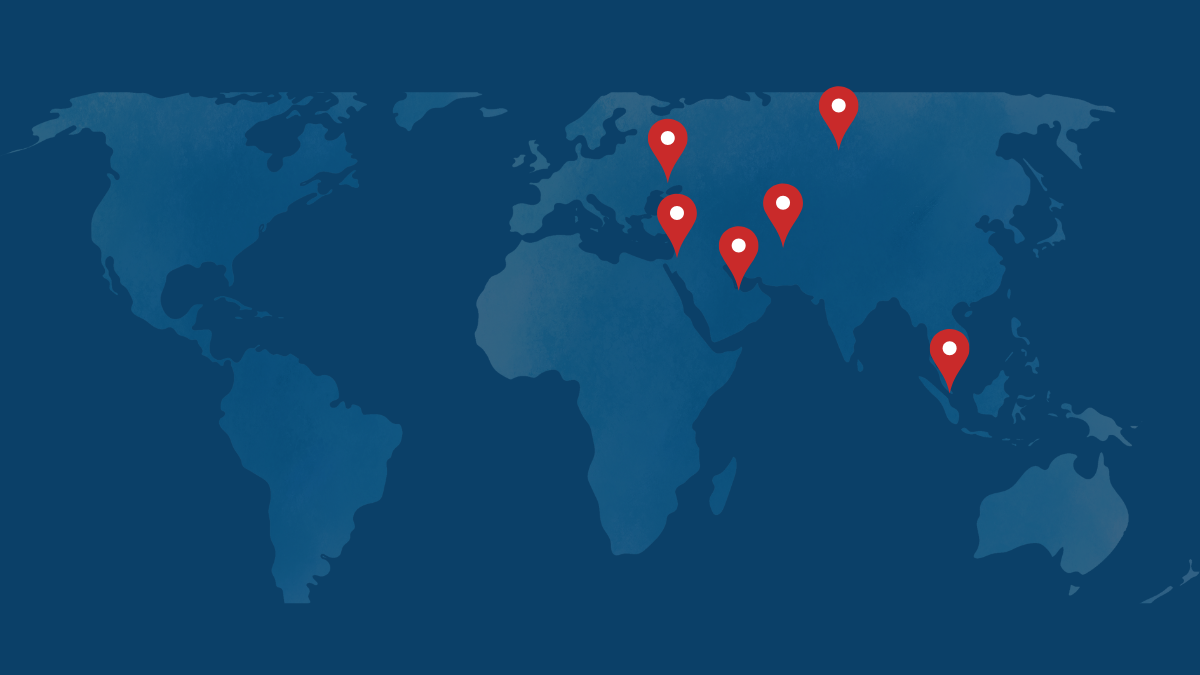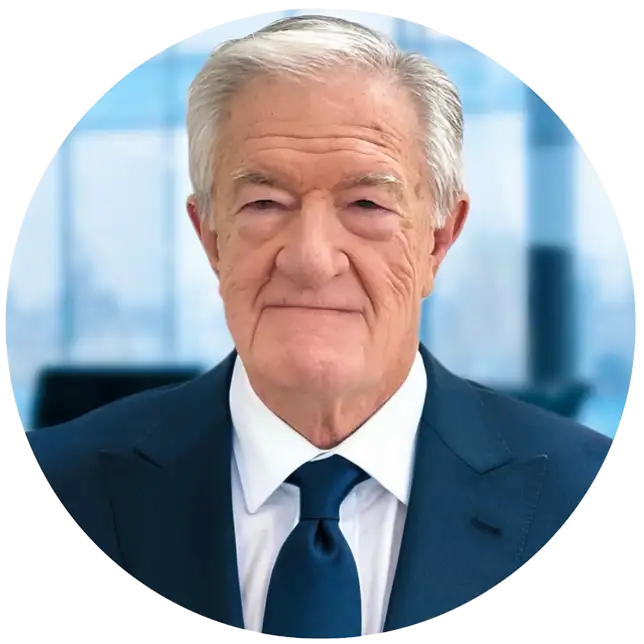
Dear Friends,
In the competition between the world’s heaviest economic hitters, there’s a ripe space for other well-positioned nations to build clout and exploit the tensions all around them. We’re seeing this in the Middle East, where Qatar continues to have an outsized impact on the Gaza ceasefire negotiations, in Afghanistan, where the Taliban is reassessing relations with Russia, India, and the United States, and in places like Malaysia, where the ongoing US-China competition for rare earth materials is presenting new financial investments. Meanwhile, the ongoing war between Ukraine and Russia continues to impact the global financial landscape, further amplified this week by a new set of US sanctions on Russian oil companies and the possible use of billions in frozen Russian assets held in Europe to aid Ukraine. Along the way, key countries like India are considering how to weigh Russian and American demands to their best advantage. The strategic balancing act comes with risks and opportunities—ready for the savvy to claim.
Kind Regards,
Jack Devine
CIA Spymaster & Chairman, TAG Intel
Emerging World (Dis)Order
There’s a lot happening on the Russia-Ukraine front and in the span of a single week the Trump administration hosted President Zelenskyy at the White House, canceled a summit with President Putin in Budapest, and unveiled the most significant US sanctions against Russia since President Trump’s return to office—all while stopping short of giving Ukraine the long-range Tomahawk missiles Zelenskyy has requested. But Trump is also granting Ukraine more extensive use of European long-range weapons that are backed by US technology, and India might be ready to finally start reducing its imports of Russian oil under the pressure of increased sanctions. If it looks like there’s a lot of push and pull going on to encourage negotiations here, that’s because there is.
The latest US sanctions target Russia’s two largest oil companies, Rosneft and Lukoil, as well as their subsidiaries, effectively barring Americans from doing business with them. European partners joined in on the sanctions, in addition to moving toward a €140 billion ($163 billion) “reparations loan” backed by interest generated from Russia’s frozen assets, a plan that could help sustain Ukraine as US military aid continues to dwindle. Some analysts warn that this risks retaliation and reputational damage for Europe as a financial safe haven, but it’s a calibrated risk given that Russia’s aggression continues to mount.
International crude prices jumped more than $2 per barrel following the announcement of coordinated US and EU sanctions, with Brent crude surging over 5%, its sharpest one-day rise in months. The measures could ripple far beyond Russia: China, India, and Turkey—Moscow’s largest energy customers—all risk being caught in secondary effects if enforcement tightens. Moscow’s embassy in London warned that targeting Russia’s major oil producers would “disrupt global fuel supplies and increase costs worldwide,” a message clearly aimed at exploiting Western fears of inflation and energy instability.
Although Russian officials and analysts have publicly shrugged off the new penalties, the internal picture is more complicated. Wartime inflation remains elevated, the central bank has pushed interest rates above 16 percent to contain price growth, and Russia’s earlier wartime boom has slowed to roughly 1 percent GDP growth — a sharp drop from 4 percent last year. Oil and gas exports account for roughly a quarter of Moscow’s federal budget, and revenues are projected to fall by $35 billion this year. Long-range Ukrainian strikes have also increasingly targeted Russian oil refineries and arms plants, eroding industrial capacity and amplifying domestic supply-chain pressure.
And with regards to long-range weapons, Trump’s decision to lift restrictions on Ukraine’s use of certain European long-range missiles, such as the British-supplied Storm Shadow, marks another subtle but important inflection point. The missiles rely on US targeting intelligence data, meaning Washington’s approval effectively greenlights cross-border attacks into Russia and increases pressure on the Kremlin. Kyiv has already used the system to hit an explosives and rocket-fuel plant in Bryansk, penetrating Russian air defense.
Putin still appears unwilling to stop the war at the current front lines and is instead willing for his troops and citizens to bear a great degree of pain. But with oil revenues sliding, inflation biting, and war fatigue setting in, Russia’s resilience may soon depend less on battlefield positions and more on its ability to weather a slow economic grind — one that Western policy now seems intent on accelerating.
Middle East in Flux
After more than two years of war and diplomatic wrangling, the guns in Gaza have finally fallen mostly silent, but the ceasefire is shaky. In early October 2025, Israel and Hamas entered a fragile ceasefire brokered by the US with assistance from Egypt and Qatar. The deal laid out a phased plan: Hamas would release Israeli hostages in exchange for Palestinian prisoners, Israeli forces would pull back from parts of Gaza, and humanitarian aid would begin flowing back into the devastated enclave.
I’ve been watching closely Qatar’s role, as it has acted as one of the few intermediaries trusted, if uneasily, by both sides. From discreet meetings in Doha to high-stakes calls with Washington and Cairo, Qatari diplomats have served as the main conduit to Hamas’s political wing. Their involvement has been key to keeping communication channels open and to securing the release of hostages, many of whom were freed only after Qatari negotiators brokered last-minute compromises. Qatar is increasingly positioning itself as the 21st century’s Switzerland—in the Middle East but also further afield—and Qatari diplomats seem to have played this latest round quite effectively.
So far, the initial phase has largely held. All twenty surviving hostages have been freed, and for the first time in nearly a year, civilians in Gaza are experiencing a moment of relative calm. Aid convoys have begun to trickle through reopened crossings, though the flow remains far short of what’s needed.
But beneath the surface, the truce is fraying a bit at the edges, and the future remains uncertain. Both sides accuse the other of repeated violations: Hamas of firing on Israeli troops near Rafah and Israel of carrying out retaliatory strikes in response. Prime Minister Netanyahu insists Israel will not allow Hamas to rearm, while Hamas leaders warn that continued blockades amount to bad faith. Meanwhile, there’s also domestic political turmoil within Gaza that’s already resulted in oppression and violence against civilians.
The next steps—a full Israeli withdrawal, Hamas’s demilitarization, and a framework for reconstruction—remain elusive at best. Each day without progress adds to fears that the pause could collapse. For now, the cease-fire holds, but it is tenuous. Whether it leads to a lasting peace or simply a lull before the next round of violence will depend on Washington and regional capitals’ ability to keep the pressure on both sides and forge a workable solution for at least the near- to medium-term.
Resource Security, Tech, and Competition
Like Qatar, which has been able to position itself as a mediator, Malaysia is also reaping the benefits of being relevant and open to business with members of powerful rivalries. This week, right ahead of hosting the upcoming ASEAN Summit, Malaysia’s trade minister announced that the nation is encouraging foreign companies to start joint ventures on rare earth pursuits. This is especially interesting given that Australian company Lynas has a significant rare earth processing location in Malaysia, and that Washington and Australia just inked a major deal on rare earth exploitation and processing. Of note, in addition to its substantial rare earth offerings from Malaysia and Australia itself, Lynas also has a location in Texas—one of the few processing facilities in the United States.
Indeed, when it comes to rare earths, Chinese processing dominance might be the greatest threat of all. China is actively wielding restrictions on rare earth exports as a political and economic weapon against the United States. While Malaysia’s processing facilities and capabilities currently pale in comparison to China’s, it presents an opportunity for growth that’s seemingly recognized by other Sino-skeptic countries: Japan was especially keen on Lynas’ Malaysia location to offer an alternative to Chinese purchases.
As it stands right now, Malaysia is looking to have it all, bringing in foreign investment while trying to keep a piece of it for itself. And given that the US and Australia now have a rare earth agreement and want to leverage any and all opportunities outside of China, Malaysia has a solid opportunity to exploit the current demand and local processing know-how. As Malaysia navigates this balance, other nations like Pakistan will certainly be watching and trying to ascertain how and if it’s possible to stay friends with two kids who both want to dominate the schoolyard.
TAG’s due diligence services help investors uncover who truly controls the assets and technologies shaping tomorrow’s industries. Explore our offerings.
Weekly Wildcard
In line with this week’s theme of power competition, Afghanistan is in the headlines once again, as an emerging China–India realignment presents the Taliban with both economic opportunity and geopolitical leverage. Of course, this will depend on whether it can strengthen governance and internal stability, which is no small matter. Since its lightning takeover of the Afghanistan in 2021, the Taliban’s rule has been marked by factionalism, insurgencies, and tribal rivalries that continue to challenge its ability to govern effectively. But the country’s strategic geography in Central Asia, which has always made it a valuable asset, is drawing renewed attention from major powers who are looking to potentially gain a foothold while the country is in a vulnerable political state.
Back in July, Russia became the first country to formally recognize the Taliban and just two weeks ago the Russians welcomed a Taliban delegation to Moscow. Russian Foreign Minister Lavrov expressed interest in expanding business ties with the new government but also warned them against allowing any foreign military presence to take hold once again. I’m assuming that here, the Russians were likely trying to get ahead of the game, recognizing that American officials are quietly reopening diplomatic channels and exploring the possible unfreezing of billions of dollars in frozen Afghan assets. The Bagram Air Base, once the centerpiece of US military power in the region, has reemerged as a symbol of Washington’s intent to reassert influence and counter the expanding presence of China and Russia, but so far, the Afghans haven’t agreed to grant the US access.
But it’s not only about countering Russia here. For Beijing, Afghanistan has taken on increased strategic importance since the US withdrawal. China sees Afghanistan as both a source of vital minerals and a geographic bridge linking western China to the Middle East, advancing its Belt and Road ambitions through investment and cooperation within the Shanghai Cooperation Organization (SCO). And if India and China can somehow cooperate rather than compete here, it could allow major infrastructure projects that would make Afghanistan an indispensable hub linking Central Asia, South Asia, and the Middle East.
For the Taliban, the great-power courtship continues to present Afghanistan and its suitors with both opportunity and danger. While the Taliban might be looking to exploit the current power rivalries, border clashes with Pakistan, ISIS-K insurgencies, and internal factional rifts all threaten to unravel the fragile political balance in Kabul, and I don’t see that changing. Normalized Taliban rule will open the door for limited—albeit increasing—engagement, but the unstable situation on the ground will likely test Afghanistan’s ability to turn strategic advantage into lasting stability.




